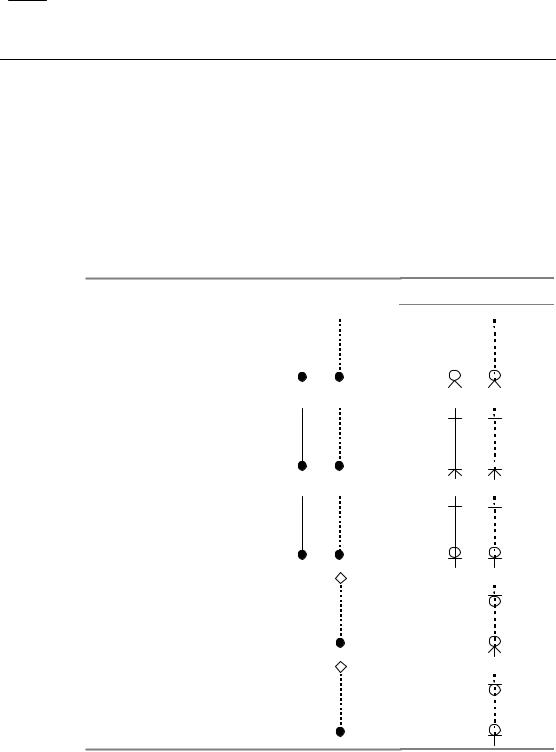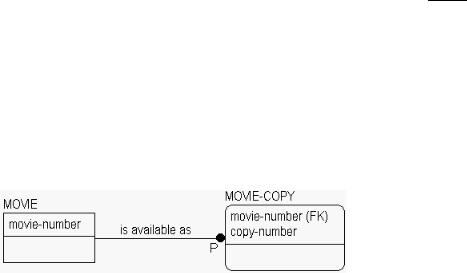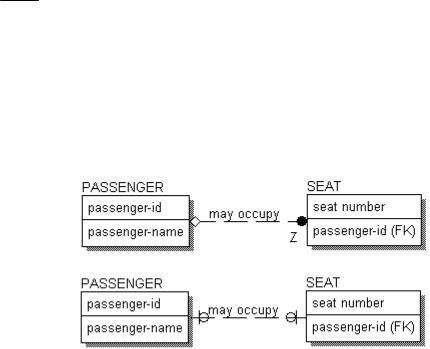
- •Contents
- •Preface
- •Intended Audience
- •About this Guide
- •Typographical Conventions
- •Related Documentation
- •What’s In This Chapter?
- •Chapter Contents
- •What is Data Modeling?
- •Data Modeling Sessions
- •Session Roles
- •Sample IDEF1X Modeling Methodology
- •Logical Models
- •The Entity Relationship Diagram
- •The Key-Based Model
- •The Fully-Attributed (FA) Model
- •Physical Models
- •The Transformation Model
- •The DBMS Model
- •Benefits of Modeling in ERwin
- •What’s In This Chapter?
- •Chapter Contents
- •The Entity-Relationship Diagram
- •Defining Entities and Attributes
- •Logical Relationships
- •Many-to-Many Relationships
- •Validating the Design of the Logical Model
- •Data Model Example
- •What’s In This Chapter?
- •Chapter Contents
- •Understanding Keys
- •Selecting a Primary Key
- •Designating Alternate Key Attributes
- •Inversion Entry Attributes
- •Relationships and Foreign Key Attributes
- •Dependent and Independent Entities
- •Identifying Relationships
- •Non-Identifying Relationships
- •Rolenames
- •What’s In This Chapter?
- •Chapter Contents
- •Naming Entities and Attributes
- •Synonyms, Homonyms and Aliases
- •Entity Definitions
- •Descriptions
- •Business Examples
- •Comments
- •Definition References and Circularity
- •Constructing a Business Glossary
- •Attribute Definitions
- •Rolenames
- •Definitions and Business Rules
- •What’s In This Chapter?
- •Chapter Contents
- •Relationship Cardinality
- •Cardinality in Non-Identifying Relationships
- •Referential Integrity
- •Reading Referential Integrity Options
- •RI, Cardinality, and Identifying Relationships
- •RI, Cardinality, and Non-Identifying Relationships
- •Additional Relationship Types
- •Many-to-Many Relationships
- •N-ary Relationships
- •Recursive Relationships
- •Subtype Relationships
- •Complete Versus Incomplete Subtype Structures
- •Inclusive and Exclusive Relationships
- •IDEF1X and IE Subtype Notation
- •When to Create a Subtype Relationship
- •Introduction
- •Chapter Contents
- •Overview of the Normal Forms
- •Functional Dependence (FD)
- •Full Functional Dependence
- •First Normal Form (1NF)
- •Second Normal Form (2NF)
- •Third Normal Form (3NF)
- •Common Design Problems
- •Repeating Data Groups
- •Multiple Use of the Same Attribute
- •Multiple Occurrences of the Same Fact
- •Conflicting Facts
- •Derived Attributes
- •Missing Information
- •Unification
- •How Much Normalization Is Enough?
- •Conclusions
- •ERwin Support for Normalization
- •First Normal Form Support
- •Second and Third Normal Form Support
- •What’s In This Chapter?
- •Chapter Contents
- •Creating a Physical Model
- •Denormalization
- •Classification of Dependent Entities
- •Glossary of Terms
- •Index
- •Documentation Comments Form

5 |
ERwin Methods Guide |
|
|
Relationship Cardinality
Up to this point, we have discussed one-to-many relationships in a logical model, without capturing any information on what we mean by the word “many.” The idea of “many” does not mean that there has to be more than one instance of the child connected to a given parent. Instead the “many” in one-to-many really means that there are zero, one or more instances of the child paired up to the parent.
Cardinality is the relational property that defines exactly how many instances appear in a child table for each corresponding instance in the parent table. IDEF1X and IE differ in the symbols are used to specify cardinality. However, both methods provide symbols to denote one or more, zero or more, zero or one, or exactly N, as explained in the following table.
Cardinality |
IDEF1X Notation |
|
IE Notation |
||||||
Description |
Identifying Non-identifying |
Identifying Non-identifying |
|||||||
One to zero, one, or more |
|
|
|
|
|
|
|
|
|
|
|
|
|
|
|
|
|
|
|
|
|
|
|
|
|
|
|
|
|
|
|
|
|
|
|
|
|
|
|
|
|
|
|
|
|
|
|
|
|
One to one or more
P P
One to zero or one
Z Z
Zero or one to zero, one, or more (non-identifying only)
Zero or one to zero or one (nonidentifying only)
Z
48 ∙ Refining Model Relationships

ERwin Methods Guide |
5 |
|
|
Cardinality lets you specify additional business rules that apply to the relationship. In the example below, the business has decided to identify each MOVIE COPY based on both the foreign key “movie-number” and a surrogate key “copy-number”. Further, each MOVIE is available as one or more MOVIE COPYs. The business has also stated that the relationship is identifying, that MOVIE COPY cannot exist unless there is a corresponding MOVIE.
Cardinality in a One-to-Many Identifying Relationship
The MOVIE-MOVIE COPY model also specifies the cardinality for the relationship. The relationship line shows that there will be exactly one MOVIE, and only one, participating in a relationship. This is because MOVIE is the parent in the relationship.
By making MOVIE-COPY the child in the relationship (shown with a dot in IDEF1X), the business defined a MOVIE-COPY as one of perhaps several rentable copies of a movie title. The business also determined that to be included in the database, a MOVIE must have at least one MOVIE-COPY. This makes the cardinality of the “is available as” relationship one-to-one or more. The “P” symbol next to the dot represents cardinality of “one or more.” As a result, we also know that a MOVIE with no copies is not a legitimate instance in this database.
In contrast, the business might want to know about all of the MOVIEs in the world, even those for which they have no copies. So their business rule is that for a MOVIE to exist (be recorded in their information system) there can be zero, one, or more copies. To record this business rule, the “P” is removed. When cardinality is not explicitly indicated in the diagram, cardinality is one- to-zero, one or more.
Cardinality in Non-Identifying Relationships
Non-identifying relationships contribute keys from a parent to a child entity. But, by definition, some (or all) of the keys do not become part of the key of the child. This means that the child will not be identification-dependent on the parent. And there can be situations where an entity at the “many” end of the relationship can exist without a “parent,” i.e., it is not existence-dependent.
Refining Model Relationships ∙ 49

5 |
ERwin Methods Guide |
|
|
If the relationship is mandatory from the perspective of the child, then the child is existence-dependent on the parent. If it is optional, the child is neither existence nor identification-dependent with respect to that relationship (although it may be dependent in other relationships). IDEF1X uses a diamond to indicate the optional case, while IE includes a circle at the parent end of the relationship line.
Cardinality in a One-to-Many, Non-Identifying Relationship Using IDEF1X (top) or IE (bottom)
In the example, the attribute “passenger-id” is a foreign key attribute of SEAT. Because the “passenger-id” does not identify the SEAT, it identifies the PASSENGER occupying the SEAT, the business has determined that the relationship is non-identifying. The business has also stated that the SEAT can exist without any PASSENGER, so the relationship is optional. When a relationship is optional, the diagram includes either a diamond in IDEF1X or the circle in IE notation. Otherwise, the cardinality graphics for nonidentifying relationships are the same as those for identifying relationships.
The cardinality for the relationship, indicated here with a “Z” in IDEF1X and a single line in IE, states that a PASSENGER <may occupy> zero or one of these SEATs on a flight. Each SEAT can be occupied, in which case the PASSENGER occupying the seat is identified by the “passenger-id”, or it can be unoccupied, in which case the “passenger-id” attribute will be empty (NULL).
50 ∙ Refining Model Relationships
